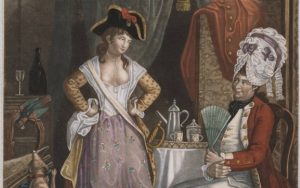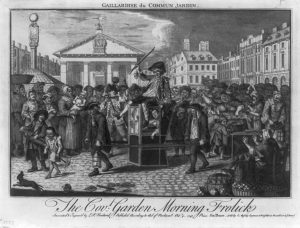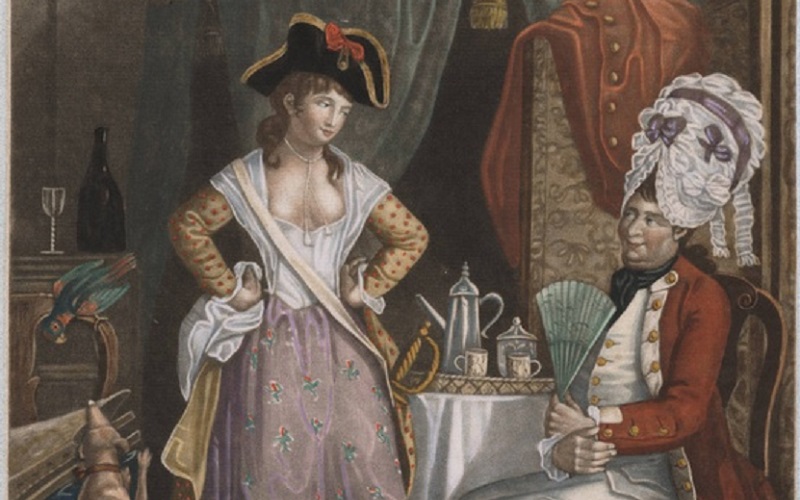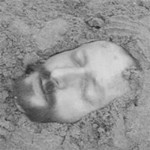 WORDS: Alex Cochrane
WORDS: Alex Cochrane
In the 18th century the secret world of the molly house was a place for gay men to socialise, cross-dress and role-play. But it was also a place of danger and treachery.
It must have taken some courage.
Walking through the teeming, rowdy streets with your pick-up. Perhaps you’re also carrying a bag with secret and dangerous contents. Adrenaline surges, heart thumps, senses in overdrive alert yet still you do it. Excitement mixes with fear, arousal and the keenest anticipation. You and your lover scan the crowd and street loungers. The crowd is anonymous but sometime you are not. You enter one of London’s worst rookeries; a slum notorious for its criminality yet gives you and your kind some protection. Finally, you knock on a tavern door. The security checks you out. The door opens. The relief and elation sweep through you as you enter for an evening of cross-dressing, role-playing and sex.
Welcome to the molly house!
In the 18th and 19th century molly houses were places where gay men could meet and socialise. Molly comes from the word moll, a word for a lower class woman, often a prostitute. It also came to mean an effeminate, usually gay man.
Molly houses could found be in taverns, pubs coffee houses or private places. They were the more organised part of London’s thriving underground gay culture. At the time gay sex was illegal – sodomy was a capital offence under the Buggery Act of 1533. Men usually had to be caught in flagrante delicto to provide enough evidence for a conviction. The molly house offered some protection and privacy, and in a raid there could be precious minutes of delay.
Even so, gay men were still vulnerable to blackmailers, agent provocateurs, entrappers seeking reward or favours, and informers – often gay men with a grudge, or caught and turned by the authorities in exchange for immunity.
Then there were the undercover agents of the religious Societies for the Reformation of Manners who sought to eliminate vice and immorality by targeting the prostitutes, Sabbath breakers and gay men.
 Molly houses often sheltered in areas notorious for criminality; where the law was less likely to intrude. The most famous molly house was run by the sympathetic and supportive Mother Clap in Field Lane, Holborn – this was the location for Fagin’s den in Dicken’s Oliver Twist.
Molly houses often sheltered in areas notorious for criminality; where the law was less likely to intrude. The most famous molly house was run by the sympathetic and supportive Mother Clap in Field Lane, Holborn – this was the location for Fagin’s den in Dicken’s Oliver Twist.
So what happened in the molly house? It was a secret world where, sadly, most historical insight comes from the court records and statements of those snared by the legal process. Even what we know is often to question, as it arises from accusation and counter-accusation.
Gay men would socialise, drink and find partners. They developed female personas and mannerisms, giving themselves names such as Garter Mary, Aunt England, Hanover Kate or Black Moll.
There was also cross-dressing and role-playing where mollies adopted female and family roles. They participated in marriage ceremonies, often a synonym for sex, but sometimes actual ceremonies to symbolise partnerships and commitment. In houses such as Mother Clap’s, there were sometimes rooms referred to as the Marrying Room or The Chapel which usually contained a double-bed where a couple could retire, yet often leaving the door open for others to watch.
They cross-dressed as milk maids, shepherdesses or in the latest female fashions. They acted out mock birth rituals, assisted by fellow mollies playing the roles of midwives. The baby could be a wooden doll, baptised and cherished. The role-playing of birth rituals doesn’t, as far as I know (and as a straight man I don’t pretend to be an expert), have a modern equivalent. Was it a response to the mood and values of the time?
One suggestion is that the mock-birth rituals were a couvade, a way of relieving the enormous pressure and stress of being a gay man. One historian, Randolph Trumach, suggests that it was a response to how family and household were considered fundamental to society at the time. Male and female roles had evolved to become more fixed. Men were supposed to be active, assertive, running the show and certainly not effeminate. Women, of course, were supposed to bear the passive, maternal and domesticated roles. It was near impossible for two men to set up home together although there were exceptions. The men of the molly houses were surely affected by the same pressures and desires for domesticity as any other social group. It poses another question of whether men, gay or straight, long to explore a femininity disapproved by a less fluid masculine society?
In the 1720s a wave of persecution peaked with a raid by the police, working with the Society for the Reformation of Manners, on Mother Clap’s molly house. Surveillance had been instigated on her house two years previously after information was received by Mark Partridge. Partridge had been outed by his lover and in revenge spread rumours about him visiting molly houses. It’s probable the rumours reached the police who forced Partridge to become an informer in return for immunity.
Mother Clap was found guilty of disrepute and sentenced to stand in the pillory in Smithfield where she was severely treated by the mob. She had to pay a fine of 20 marks, and suffer two years’ imprisonment. It’s unknown whether she survived her sentence. Half a dozen of her customers suffered a similar fate but three of her customers were hanged for sodomy at Tyburn.
It wasn’t until 1861 that Section 61 of the Offences against the Person Act 1861 removed the death penalty for homosexuality, but male homosexual acts remained illegal and were punishable by imprisonment.
Further reading:
http://www.cabinetmagazine.org/issues/8/bailey.php
http://rictornorton.co.uk/eighteen/mother.htm
https://en.wikipedia.org/wiki/Margaret_Clap
Alex Cochrane is based in Glasgow and blogs about exploration, travel, history, historical erotica and other curiosities at https://adcochrane.wordpress.com. You can also follow Alex on Twitter at @alexdcochrane









wanneer krijg ik mn prijs in huis